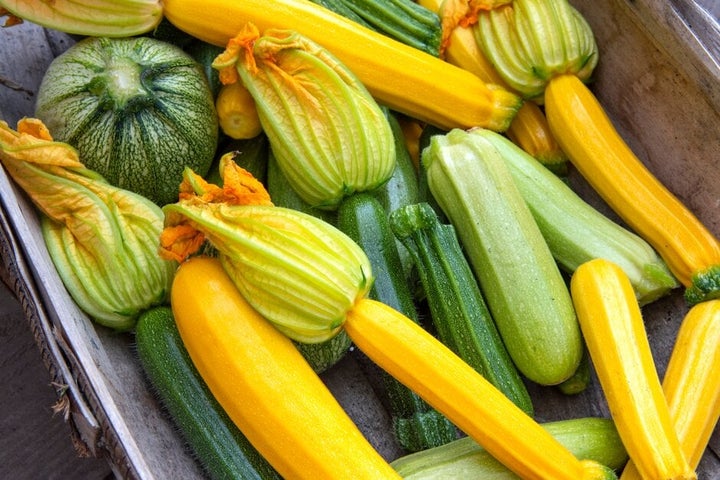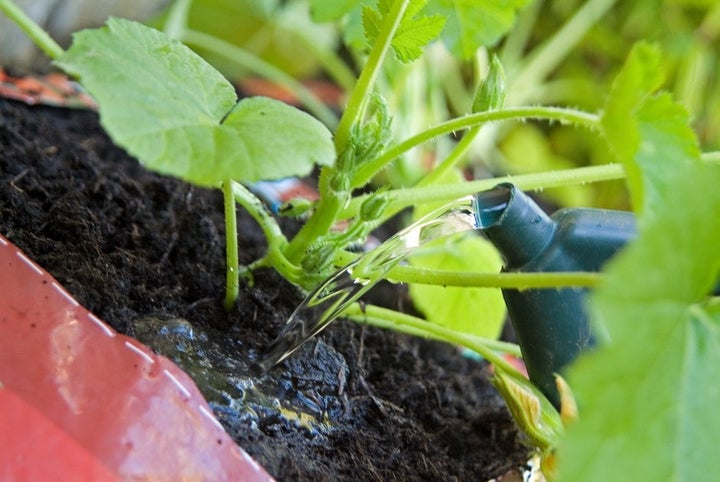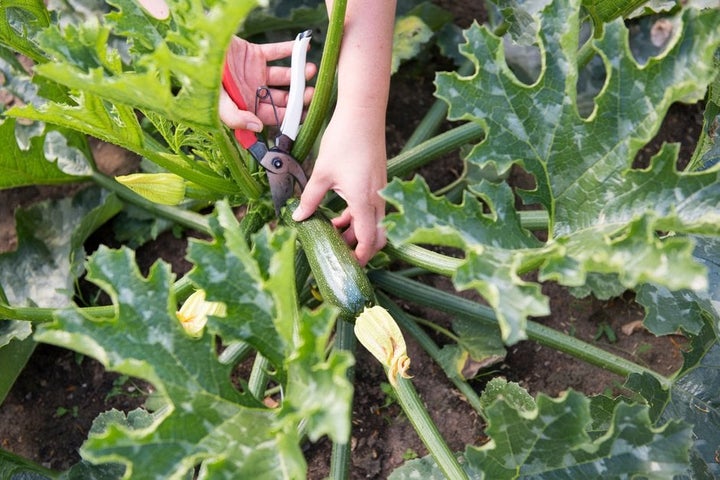Getting Started

Courgette plants are easy to grow and fruit abundantly over the summer months – you can expect three or four fruits a week from one plant in good weather. Also known as zucchini, courgettes (Cucurbita pepo) are tender, so are best sown indoors in spring, for transplanting outdoors in early summer.
They like a warm, sunny, sheltered position, with rich soil and regular watering. They form large vigorous plants, so need about a square metre of ground each. Alternatively, climbing varieties can be trained vertically up canes or wires and compact varieties can be planted in a large container or growing bag if you’re short on soil space.
There are many varieties to choose from, with fruits in various shades of green or yellow, either long or rounded in shape. You can pick them at any size, but the flavour and texture is best when they’re small. The flowers are also edible. Regular harvesting encourages plants to keep on cropping. If left, courgette fruits will quickly grow into marrows.
Month by Month
Sow
Plant Out
Harvest
Choosing What To Grow
There are many courgette varieties to choose from – some forming large trailing plants, ideal if you have plenty of space, while others are bushy and compact, so great in small veg plots and large containers. Many varieties are attractive as well as productive – the fruits can be various shades of green or yellow, striped or plain, and either long or spherical, and the large leaves can be green, mottled or silvery. Spine-free varieties make harvesting easier, while disease-resistant varieties are a good choice in areas prone to damp or humid summers.
For the most reliable croppers, look for varieties with an RHS Award of Garden Merit (AGM), as these performed well in our trials – see our list of AGM fruit and veg (135kB pdf) and our Recommended Varieties below. You’ll also find courgettes growing in the veg areas of RHS gardens over the summer months, so do visit to compare varieties and pick up growing tips.
What and where to buy
A wide array of courgette seeds are available from garden centres and online seed retailers. You can also buy young plants in spring and early summer from similar sources, ready for planting outside after the last frost. These are ideal if you don’t have the time or space to grow from seed, but you may find the choice of varieties is fairly limited.
Recommended Varieties

'Defender' AGM
Very popular variety, produces a large crop over a long season if picked regularly.

'El Greco' AGM
Prolific cropper, and plants have an open growth habit, making picking easy.
Preparing The Ground
Choose a warm, sunny position for courgettes, where you can space plants at least 90cm (3ft) apart. Dig in lots of garden or well-rotted manure at each sowing/planting site, into an area roughly the depth and width of a spade’s blade. Ideally do this a few weeks before sowing or planting out, to allow the soil to settle. If you're practising no-dig, the soil at each site ahead of sowing or planting directly into the mulch.
Sowing
Courgettes are easy to grow from seed. They are best started off indoors in pots in mid- to late spring, but you can also sow them outdoors in early summer, especially in warmer regions.
Sowing indoors
For an earlier crop or in colder regions, start courgettes off indoors in April or early May. tends to be more reliable indoors and the are out of reach of slugs and snails until they’re planted out, when larger and more robust.
Sow the seeds individually on their side, 13mm (½in) deep, in 7.5cm (3in) pots or modular trays filled with moist peat-free . Then place in a or on a sunny windowsill covered with a clear lid or polythene bag. The seeds need 18–21°C (65–70°F) to germinate. Once seedlings appear, take them out of the or remove the bag. For more sowing tips, see our guides below.
Sowing outdoors
You can sow seeds outdoors in late May or early June, once the soil warms up. Prepare the ground as detailed above, then sow two or three seeds, 2.5cm (1in) deep, at intervals at least 90cm (3ft) apart. Make your sowings in the centre of your patch, so plants can sprawl in all directions.
Water well and cover each sowing with a cloche or plastic-free fleece, leaving this in place for as long as possible after . If more than one seed germinates in any site, remove the smaller, weaker to leave just the strongest one.
Germination outdoors may be less reliable than indoors, and seedlings are more vulnerable to slugs and snails, especially in damp conditions. Outdoor-sown plants will usually start cropping later than those sown earlier indoors.
Planting
Young, well-rooted courgette plants grown from seed indoors should be ready for planting out in early summer, once the soil has warmed up. If you haven’t grown your own, you can simply buy young plants in late spring and early summer.
Harden off your courgette plants before planting, to gradually acclimatise them to outdoor conditions, and make sure your planting sites are prepared in advance (see Preparing the ground above). Then carefully remove each young plant from its pot, without disturbing the roots, and plant into the centre of your prepared sites, at least 90cm (3ft) apart. Firm them in gently, then water well. Protect young plants from slugs and snails.
Planting in a container
You can also plant courgettes in large containers, in a warm sunny spot. This is a great option if you have limited soil space.
Choose a compact or bush variety and a container that’s at least 45cm (18in) wide. Fill it with peat-free soil-based or multi-purpose , then plant one young courgette plant into the centre. Water the plant in well, and continue watering regularly. Growing bags are also suitable for courgettes, and can accommodate one or even two compact plants.
Plant Care
Watering

Courgettes are thirsty plants and need regular watering, especially when growing in a container and while fruiting. Aim to keep the soil or potting consistently moist. During hot weather, plants may need watering daily. When you water, try not to wet the leaves, as this can encourage fungal diseases, such as powdery mildew.
Top tip
Sink a 15cm (6in) pot into the ground alongside your courgette plant and water into it, so the water goes directly down to the roots. The moisture doesn’t then sit around the neck of the plant, which can lead to rotting.
Use rainwater from a butt whenever possible, and on hot days water early in the morning or in the evening if you can, so the moisture doesn’t simply evaporate. For more water-wise tips, see our guides below.
Mulching
Lay a thick layer of mulch over the soil around courgette plants to help hold moisture in the ground, reduce the need for watering and deter weed . Use home-made garden compost or well-rotted manure, but leave a gap around the base of the stem, to prevent rotting.
Feeding
When growing courgettes in containers, feed every 10–14 days with a high potash liquid fertiliser once the first fruits start to swell. Plants growing in the ground don’t generally need feeding unless the soil is poor.
Pruning And Training
Remove any leaves that become tatty or are affected by powdery mildew. This helps to expose the fruits to the sun, aiding ripening, and makes finding them easier when harvesting.
Harvesting

Harvest courgettes when small, tender and full of flavour, at 10–12.5cm (4-5in) long. Regular picking while the fruits are small will ensure a long cropping period. You can also harvest the flowers, to add colour to salads or to fry or stuff with soft cheese. It’s best to choose male flowers (without the small fruit behind), so you don’t reduce fruiting.
Problem Solving
Courgettes are tender plants, so are susceptible to cold and frost. In early summer, you may find they produce no fruit or the fruits rot when very small – this is caused by cool weather, leading to poor pollination, but should remedy itself once the weather improves. Courgette plants can also be affected by various fungal diseases. See Common problems below for advice on how to spot and tackle these issues. Slugs and snails may eat young plants, flowers and young fruits.
Common Problems

Courgette, marrow, pumpkin and squash problems
Courgettes, marrows, pumpkins, squashes and other members of the cucurbit family are fun to grow. It can be worrying, then, when problems strike. Know...

Downy mildews
Downy mildews can spoil the appearance of ornamental plants and affect the yield and quality of edible crops. Control depends on cultural techniques a...

Grey mould
Grey mould, caused by the fungus Botrytis cinerea, is a very common disease, causing a soft decay of plant tissues accompanied by a growth of fuzzy gr...






